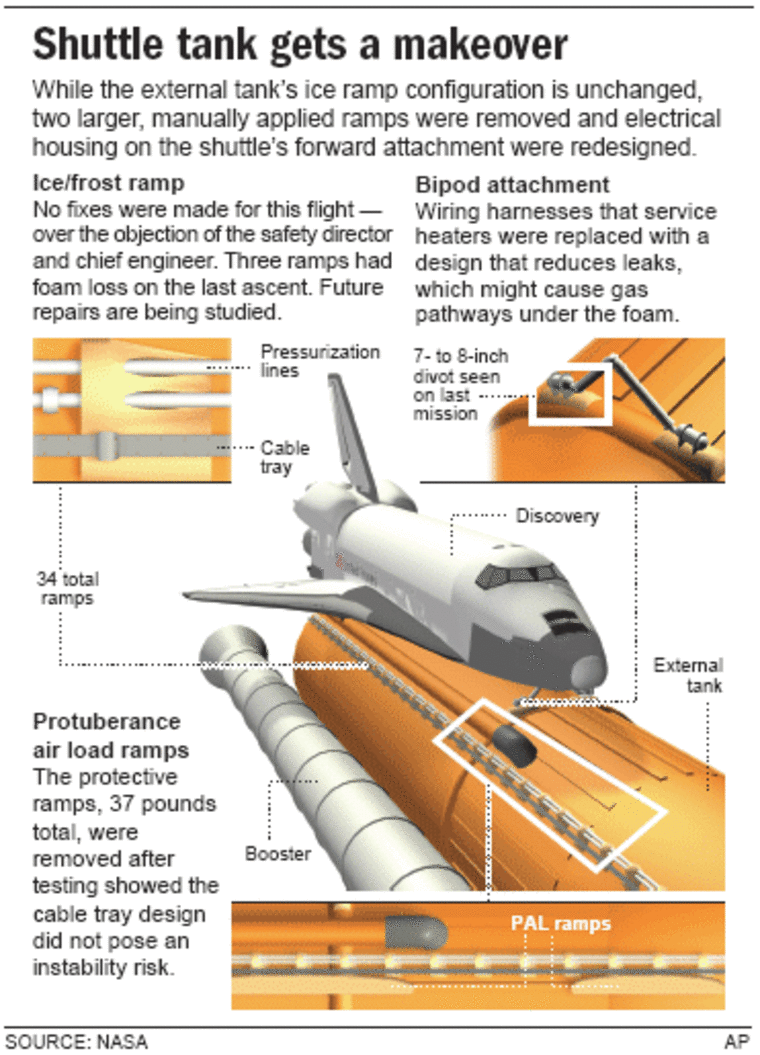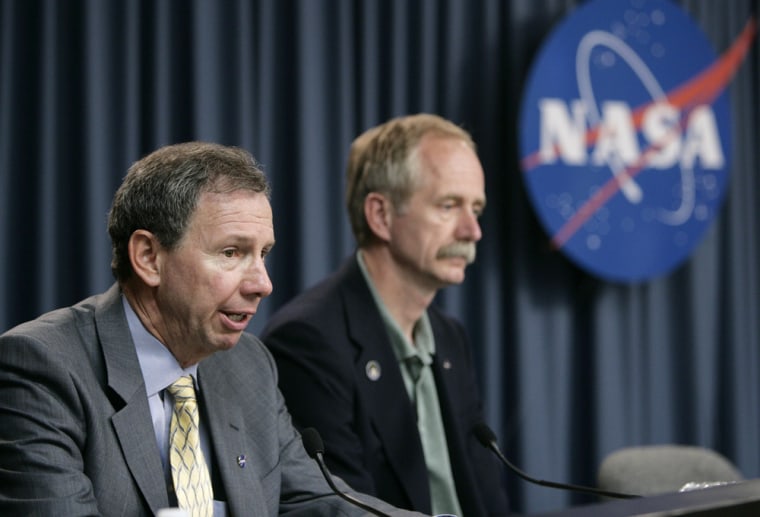CAPE CANAVERAL, Fla. - On the eve of the shuttle Discovery's scheduled launch, NASA Administrator Mike Griffin acknowledged Friday that he is "playing the odds" by giving the go-ahead for the mission despite continuing concerns about foam-insulation debris.
"As taxpayers, you pay us to play the odds," he told reporters. "It's called risk management."
Griffin's comments here at NASA's Kennedy Space Center came as the space agency continued preparations for Discovery's liftoff at 3:48 p.m. ET Saturday. The mission is to test safety improvements and procedures developed since Discovery's last flight, almost a year ago, as well as deliver supplies and a third long-term crew member to the international space station.
Forecasters said the chances of acceptable conditions rose from 40 to 60 percent overnight. The biggest concern was the possibility of rain showers or lightning near NASA's Kennedy Space Center.
Launch commentator George Diller said engineers were working on a glitch involving a heater for one of the thrusters in Discovery's attitude control system. The heater keeps the thruster's propellants from freezing in the chill of space. NASA's launch team was trying to determine how serious the glitch was — and whether it could delay the launch.
Almost a year ago at this time, launch managers were coping with a problem with fuel-tank sensors that forced the delay of Discovery's launch on the first flight since the Columbia tragedy in 2003. This time around, the sensors appeared to be working exactly as hoped, Diller said.
One issue that Griffin clearly resolved is that the launch would not be held up due to concerns about foam structures on the shuttle's external fuel tank known as ice/frost ramps. Foam insulation is of particular concern, because damage done by foam debris is thought to have been the cause of the Columbia tragedy in 2003.
Moreover, the shuttle fleet was grounded again after last year's Discovery mission because a chunk of foam was seen coming off the tank during last year's launch, leading to a redesign of the tank to remove that troublesome area of foam.
Simulations of the tank's aerodynamics has indicated that debris from the ice/frost ramps could pose a very slight risk of catastrophic damage - leading NASA's chief engineer and chief safety officer to declare that they were "no-go" for Discovery's launch until the ramps are redesigned.
Even Griffin acknowledges that the ramps need to be fixed eventually — but he said that, in the long run, holding up shuttle flights for a redesign would pose more risk than going ahead with the launch. Presented with that reasoning, the dissenters said they understood the decision and declined to pursue an appeal.

'Rolling the dice'?
On Friday, the Orlando Sentinel reported that a NASA internal investigator also cast doubt on Griffin's decision in an e-mail sent to the space agency's inspector general, Robert Cobb. Investigator Larry Neu reportedly told Cobb that Griffin and other top NASA managers were "rolling the dice but they think their odds are good."
That sparked one reporter to ask whether Griffin felt he was playing the odds in going ahead with Discovery's launch.
"You're not going to like this, and I'm sure I'm not going to like how it sounds in print, but we are playing the odds," Griffin answered. "What you pay us for, as taxpayers, is to understand those odds in great detail. When we say 'playing the odds,' what we're talking about is risk management. And to engineers, risk is expressed in terms of probability and statistics. I think we've got a team here that understands that discipline as well as any group I've seen."
Griffin said that the go/no-go decision had to strike a balance involving risks to the crew, as well as cost risks and schedule risks.
He said NASA's top managers expected to see only small pieces of foam come off the fuel tank, "released at times that are acceptable." But even if debris from the ice/frost ramps damaged Discovery to the point that it could not be flown back to Earth safely, the crew could seek shelter in the international space station and await the arrival of a rescue shuttle, Griffin said.
On the other hand, if Discovery's launch were delayed for an indeterminate amount of time, NASA would risk being unable to finish construction of the international space station by 2010, when the shuttle fleet is due for retirement. The near-term delays would significantly heighten the risks in the final years of the fleet's operation, he said.
Griffin denied that he and his team were unduly influenced by the schedule pressure, but he said "we pay attention to schedule, because time is money, and that matters."
He said that he laid out his rationale for going ahead with the launch in an e-mail to Cobb, the NASA inspector general, and that Cobb wrote back saying he was "satisfied and comfortable with my decision-making." Efforts to contact the inspector general's office late Friday were unsuccessful.
Better data, better design
NASA's associate administrator for space operations, Bill Gerstenmaier, said the enhanced imaging capability for Discovery's launch would provide more data for an assessment of the ice/frost ramps — and lead to a more informed redesign.
"If we could analyze this and test it fully on the ground, we wouldn't need to fly to gain this data to make an improvement," he told reporters. "But by flying and taking some small risk with flyng, we can gain more data that helps us make a faster improvement and improve the overall safety of the flight, and allows us to make a better design change."
Griffin said the open debate over the ice/frost ramps was not a sign that the space agency was in a fragile condition. Rather, he said, "what you're seeing is a good process — maybe you haven't seen it before."
On other issues:
- Griffin was adamant that the shuttle fleet would be retired in 2010, as scheduled. He pointed out that billions of dollars were at stake in budgeting for future operation of the shuttle program — a major factor in the "cost risk" he had to consider. He said the current schedule called for an average of 4.5 shuttle flights per year, which matched the historical average. But if NASA couldn't hit that average, would he reconsider the retirement date? Griffin had a one-word answer: "No."
- He said NASA would not release documents from this month's flight readiness review, where the ice/frost ramp controversy was discussed in depth, because the views expressed were "pre-decisional." Releasing the documents might discourage engineers from frank discussion of pre-flight issues in the future, he said. This is why a request for those documents under the terms of the Freedom of Information Act was denied, Griffin said. He acknowledged that similar documents were released relating to last year's Discovery mission — but said, "If I had it to do over, I wouldn't."
- Griffin said the ice/frost ramp issue would have to be resolved — either by coming up with an acceptable redesign or by determining that the issue wasn't really a problem after all — before NASA went ahead with a shuttle mission to service the Hubble Space Telescope one last time. Although NASA hasn't officially given its OK for such a mission, preliminary planning is under way with a target date of April 2008.
- Griffin said Discovery's launch would send an important signal to NASA's international partners. "I think if we are unable to complete the project that we have before us — the space station — we will have a certain lack of credibility in encouraging others to join us for exploration of the moon and Mars," he said. "So it's important to finish what we have started. Tomorrow's launch ... is a step back on the road to completing the station, and as such, it's important."
